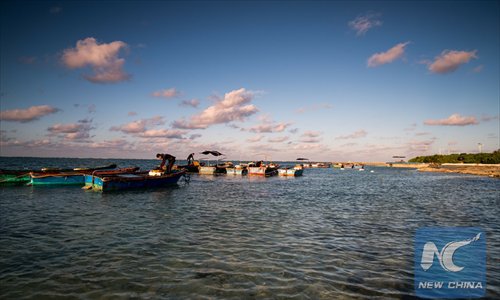HOME >> OP-ED
Manila's dangerous, futile game of involving outsiders in regional row
By Zhu Dongyang and Yang Tianmu Source:Xinhua Published: 2016-4-4 11:08:53

This photo taken on Dec. 11, 2015 shows uniquely beautiful winter scenery of the Zhaoshu Island in the South China Sea. (Xinhua file photo/Zhao Yingquan)
The upcoming US-Philippine military exercises caps Manila's recent attempts to involve outsiders in regional row. However, a provocation so fear-mongering and untimely as such is likely to boomerang on the initiators.
The 12-day annual Balikatan (shoulder-to-shoulder) exercises will be joined by the US allies of Australia and Japan for the first time in history. Held near the disputed waters of South China Sea, the joint maneuvers were widely seen as Manila's latest showoff of its military alliance with Washington, with the unprecedented participation with the US treaty allies.
Solely in March, the Philippines allowed the United States to have military access to five bases near the disputed waters with China under the renewed defense pact with the United States. It also leased military aircrafts from Japan and obtained fighters and surveillance radars from South Korea. Australia, an irrelevant outsider, also presented unconstructive concern over the South China Sea issue.
Under President Benigno Aquino III, the Philippines has been keen on making waves over the South China Sea issue. Without notice or exchanges beforehand, it sued China over the legality of its territorial claims in the International Court of Justice in The Hague, while rejecting the offer of two-way talks.
Even China's construction of facilities on its islands, in an apparent bid to promote self-defense and navigation security in nearby waters, has fallen victim to the Philippines' malicious misrepresentation, and was labeled as part of China's militarization plan to impede sea lanes and scare off smaller claimants.
These unilateral provocations have fanned fears and disturbed the tranquility of the South China Sea, which had once been well maintained partly thanks to China's signing of the Code of Conduct with relevant regional parties, including the Philippines, in 2002.
Behind the current tensions, which have been rising to the tipping point more frequently than ever, are a deep-seated suspicion of China and a much-ado-about-nothing attitude of some specific countries to gain an advantage, at the cost of regional stability.
Manila's ambitions mesh well with the thinly-veiled designs of irrelevant outsiders. Eager to undercut China's mounting regional influence, some specific nations take delight in sowing seeds of discord between China and rival claimants, and boosting their military presences and patrols to thwart China in the name of safeguarding the freedom of navigation.
Unfortunately, however, the fear-fanning provocations by the Philippines, a concerned claimant unlike the United States, have led nowhere. Over his six-year presidency that draws to an end this year, Aquino has been unable or unwilling to change his disturbing China policy. During Aquino's presidency, bilateral relations have been marked merely by disputes and distrust, while his nation was plagued by widespread poverty, and other regional players were trying to ride on the coattails of China's robust growth.
Above all, the settlement of the South China Sea issue demands a rational approach, good faith and considerable patience to engage in direct dialogue between the nations concerned. But Aquino appears to lack all of these attributes when dealing with China.
A big country with vital interests in Asia, the United States should first clarify the targets of its Pivot to Asia strategy, which so far has featured no more than unscrupulous inconsistency between fear-mongering deeds and peace-loving words.
On the South China Sea issue, it would be wise for current and incoming leaders in Manila to carefully consider China's unswerving resolve to safeguard its territorial integrity and regional stability before making a move.
Posted in: Viewpoint